“I am not interested in complicated things nor in the commonplace, I like to paint simple things that are a little strange.” – Gertrude Abercrombie
After Pied Piper and The Thinking, my explorations led me into the byways of British literature of WW2 evacuation and evacuees. On that journey, I made – and continue to make – discoveries: Writers and writing new to me although probably well known to many others. These readings have contributed to a shift in my mental pictures of wartime London and of British society in the 1940s.
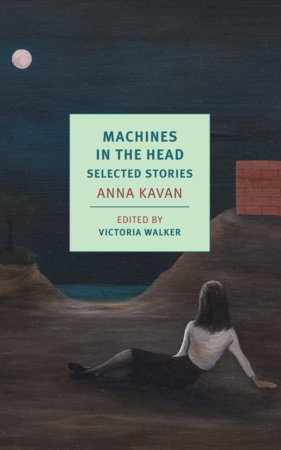
And among those discoveries is the remarkable Anna Kavan. I read her wartime stories collected in I am Lazarus, (1945) then back in time to Asylum Piece (1940) about mental illness, her breakdown, and institutionalization. And then a fast forward to her last novel – the hallucinatory and quite extraordinary Ice (1967) and finally a dip into her posthumously published collection stories about addiction – Julia and the Bazooka (1970)
Anna Kavan was also an accomplished painter. As I spent time in her haunted and haunting visual and literary world, the work of another unsettling artist came to mind: the American painter Gertrude Abercrombie (1909-1977). I’ll start with Abercrombie and then wind my way back into Kavan’s world in a later post.
A recent selection of Kavan’s stories spanning the decades – Machines in the Head – had an Abercrombie painting – Reverie 1947 – on the cover. Clearly, I am not the first to make this association between these two women.
When Gertrude met Gertrude
Abercrombie was born in Illinois, the only child of a traveling opera singer and musician. When she was four the family moved to Berlin where in a few short months she became fluent in German and could translate for her parents. When WW1 broke out the family moved back and in 1916 settled in Hyde Park, Chicago where Abercrombie would live for the rest of her life. After a degree in romance languages from the University of Illinois in 1929, she took a class in figurative drawing art at the Art Institute followed by a class in commercial art at the American Academy of Art. In 1931 she worked as an illustrator earning $15 a week drawing gloves for the Merirow Department Store. Later, she drew illustrations for Sears’ catalog.
She was hired as a painter by the Works Progress Administration from 1932 to 1940. She made $94 a month and could now rent her own apartment and move away from her conservative Christian Scientist parents. She began to establish herself within the creative community of bohemian Chicago and became a central figure in the city’s cultural milieu that included both famous and unknown writers, visual artists, and musicians.
In a conversation with Studs Terkel in 1977, Abercrombie recalled that time with fondness:
I met all kinds of people, classes, colors, creeds, everything … which I hadn’t known before … I was twenty-four … and it was just beautiful to meet all these people that I had never met. I had never met any colored people and very few Jewish people and there were so many odd people … I mean odd to me … and everybody loved each other.
Abercrombie greatly admired Gertrude Stein and – thanks to their mutual friend Thornton Wilder – the two Gertrudes met in 1935. Stein told Abercrombie that her paintings were “very pretty but girl you gotta draw better.” Abercrombie took the advice to heart and began painting There on the Table (1935), for which she later won a $100 prize at the Art Institute.
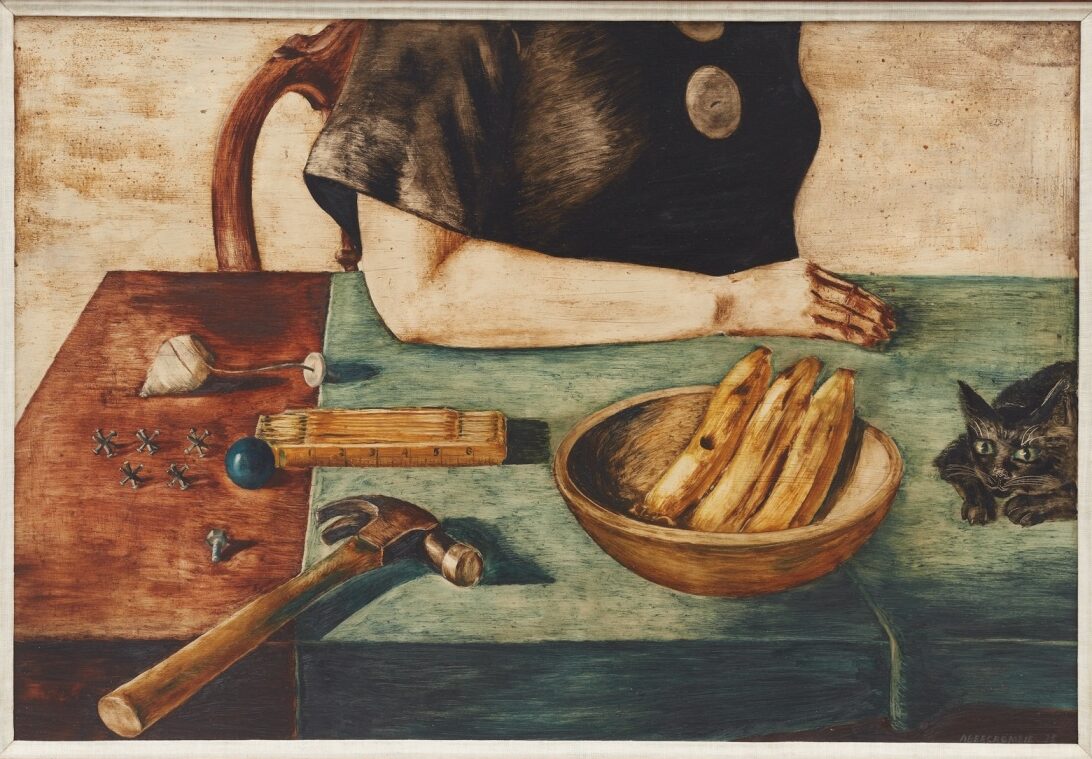
In that painting, Abercombie includes several of the elements that reappear in her work of the next decades.
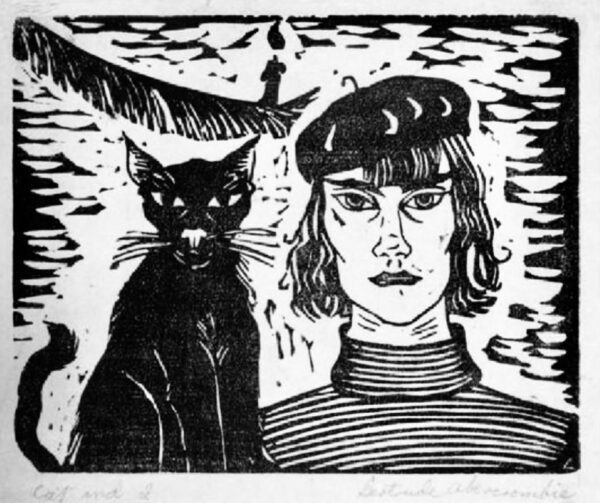
“It is always myself that I paint,”
Abercrombie primarily painted distinctive and idiosyncratic landscapes, still lives, and portraits usually in oil on masonite rather than canvas. Her landscapes are eerie, haunted, and dreamlike. Objects and planes are off-kilter with strange and distorted spatial depth.
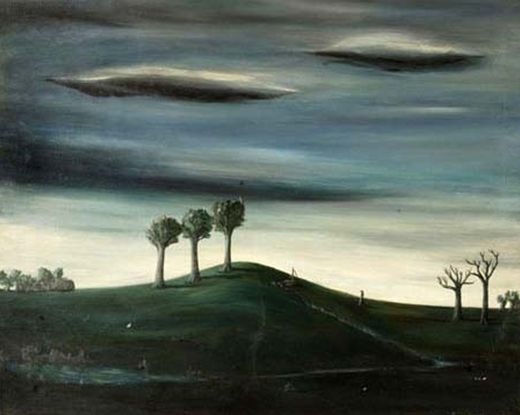
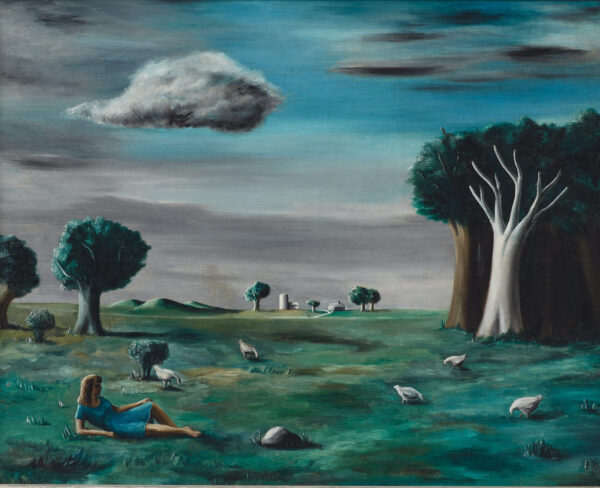
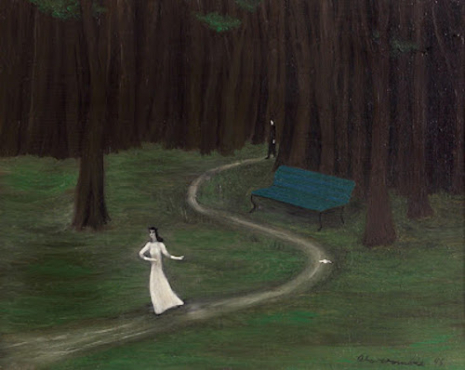
Susan Weininger called her work “psychic self-portraits.” because of their dreamy, self-referential quality. Some of the paintings have the feel of a nightmare – empty landscapes imbued with a sense of dread.
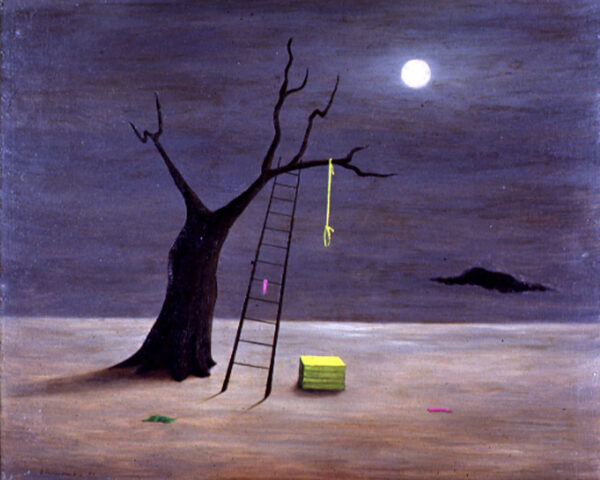
Bop Art and Party Central
There’s a contrast between her paintings – their strange and somber style, eerie symbolism, and moody color palette – and the vibrant social whirl she created in her Hyde Park house. Abercrombie sometimes referred to herself as “the other Gertrude,” in reference to Gertrude Stein’s famous salon in Paris.
Abercrombie’s gatherings were altogether wilder affairs. She cultivated and developed strong friendships with the leading jazz musicians of the era – Dizzy Gillespie, Sonny Rollins, Charlie Parker, et al – many of whom became close personal friends. She hosted Sunday afternoon jam sessions and often joined in – playing piano and singing scat. Her house was party central for Bohemian Chicago.
Jazz composer Richie Powell wrote a song for her called “Gertrude’s Bounce.”
The musicians respected Abercrombie’s work and thought of it as akin to their own. She was a free spirit – an original, who painted herself and what she felt. Because she brought a personal improvisational style to her painting, Dizzy Gillespie called her the first Bop artist. Abercrombie commented: “I told him that I invented the term “Bop” for my art, because there is a thing called Op Art and Pop Art, but I said, mine is ‘Bop Art.’ I just invented that term in the art sense, but oh no no, he and Charlie did the Bop for music.”
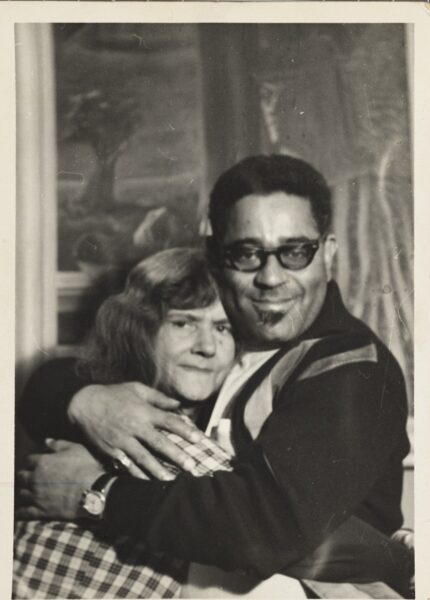
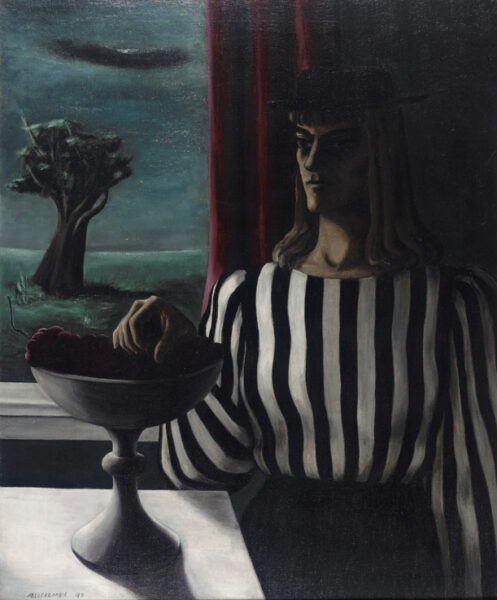
A Symbolic World
In the so-called real world, Abercrombie was warm, outgoing, and gregarious. She was a well-known figure in Chicago, exhibiting in art shows and traveling the city in an old Rolls Royce. The symbolic universe of her art suggests a very different personality. Her paintings over the decades repeatedly used the same symbols to create uncanny and unsettling scenes
Jazz musicians improvise and riff on rhythms and melodies. Abercrombie did the same with her collection of visual symbols – a set of settings, objects, characters and colors that had personal significance for her. Her repertoire of lone figures, empty landscapes, towers, pathways, windows, empty rooms, doors, windows, ladders and stairways often leading nowhere, simple houses, paintings within painting, moons, clouds, seashells, jacks, and owls, And cats. Always cats. Her paintings of tall, slender and regal women in long gowns with feline eyes are often with at least one cat.
Abercrombie loved cats and painted them – and herself with them – frequently, often in ways that create a sense of mystery and magic. It was an image of herself that she actively cultivated.
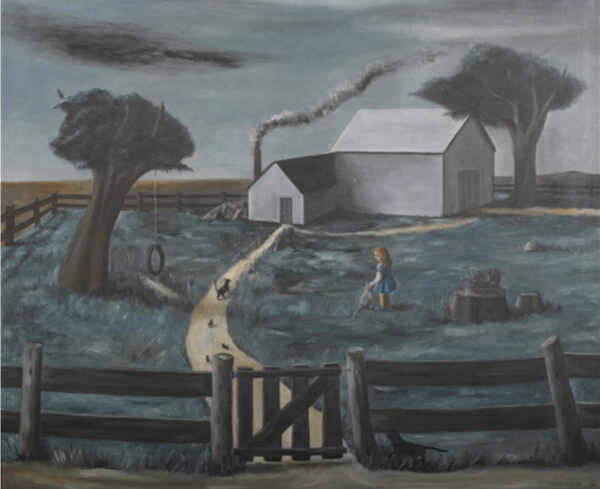
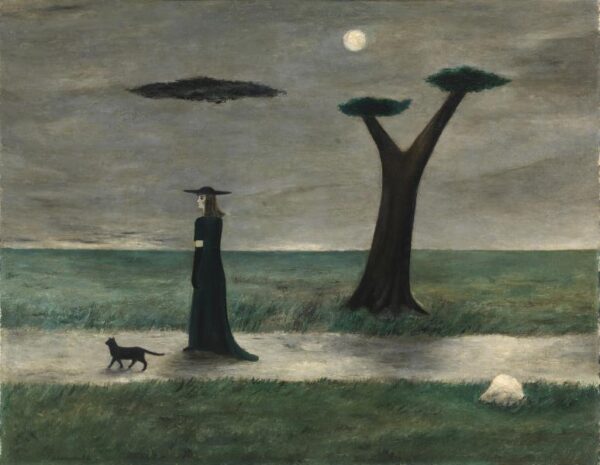
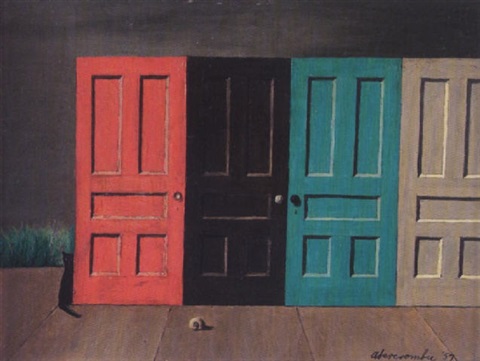
The paintings with their repeated symbols cast create a magical psychic world that is uniquely hers.
Surreal Dreamscapes
Abercrombie did not follow art movements and fashions closely and always considered herself an untrained outsider to that world. She did however take the unconscious world of her dreams seriously and her work is like a personal – and at times mid-western – take on surrealism.
Surrealism is meant for me because I am a pretty realistic person but don’t like all I see. So I dream that it is changed. Then I change it to the way I want it. It is almost always pretty real. Only mystery and fantasy have been added. All foolishness has been taken out. It becomes my own dream
Abercrombie knew that her art had elements in common with Giorgio de Chirico, Max Ernst, and Salvador Dali but the big influence on her later work was Rene Magritte whose work she discovered in the 1950s. “When I saw his work, I said to myself, ‘There’s your daddy.’ And I’ve been working in that surrealist vein ever since.”
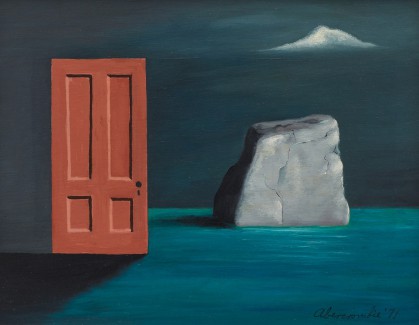
“I like to paint mysteries or fantasies—things that are real in the mind, but not real in the ordinary sense of the word.” – Abercrombie to journalist Agnes Lynch 1952.
, “Everything is autobiographical in a sense, but kind of dreamy.” – Abercrombie to Studs Terkel
The world of Abercrombie’s paintings have an uncanny almost witchy, occult feel. She plays with her chosen symbols – the meandering paths, the bare trees, the forest – empty eerie moonlit landscapes dotted with stairs, ladders, and towers, and her personal universe of chosen objects and animals.
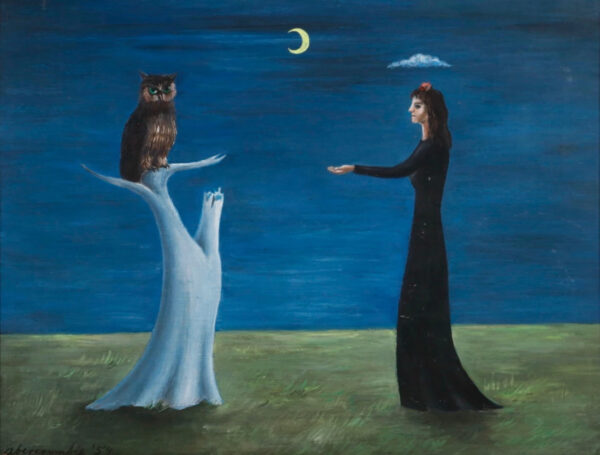
Looking at so many of Abercrombie’s mysterious paintings – living a little in her cold, isolated, unnerving visual world – sets the mood for the return to Anna Kavan and the surreal world of her novel Ice.
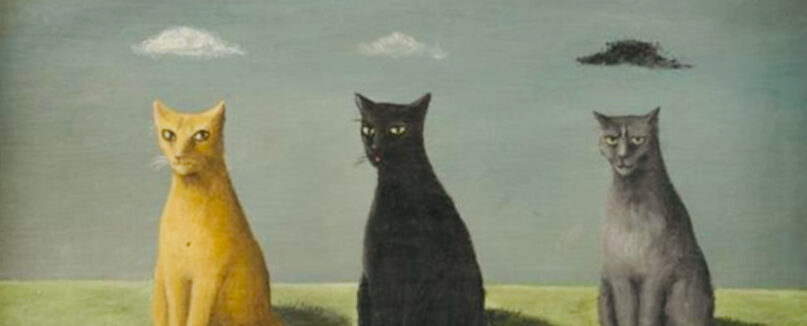


Hi Josie,
First of all, thnk you for liking couple of my posts. I had not previously heard of this artist but your essay introduces her in an irresistable fashion. As a lifelong lover of ‘Modern Jazz’ as was clled back in the 1950s, as well as surealist art, I am delighted to have made her acquaintance via your blog.
Frank Parker´s last blog post ..The Misappropriation of our Rights
Such interesting work! I didn’t know about this artist, so thank you, Josie, for the wonderful introduction.
Thanks Becky – It was fun to delve into her life and work.
Simple things that are a little strange – this feels about right!
And a little off-beam!
Thanks so much for introducing me to Abercrombie’s art, I shall look out for her more now. That mix of faux naive style and surreal subjects is definitely attractive, and I like her use of colour too. I wonder how much a Bristol artist I knew, Richard Cartwright, knew of her work and whether he was influenced by her: https://www.adamgallery.com/artists/cartwright/?gallery=Bath
I took a look at Cartwright’s work at the link. Interesting stuff. And I think you are right – there are many points of connection – the style and colour palette to name just two,
Wonderful essay on Abercrombie, Josie. Leonora Carrington is another surrealist whose work I like.
Hello Gerts: Always a buzz when you drop by. And yes – Carrington is a great comparison.
So many interesting people in the world. And so many connections. A poor ignoramus like me can hardly keep up with the unraveling threads. (Maybe that is the point – no one can. And those who think they can live with blinders.)
Indeed. The Work is never done. But I guess that’s why its so interesting.
I like her moonscapes with the highlighted path…and the two pussycats in the boat, of course. One would think she was a solitary soul and yet she had so many friends. Interesting woman. I have a slight moon obsession myself. Not to mention cats.
Hi Carolya – an owl and a pussy cat? Or two owls, or two cats? She loved her cats and owls and moonscapes.
Abercrombie was fond of wearing stripes and often drew herself in striped clothing – almost as if she contained two distinct and contrasting aspects to her personality. She was the life and soul of the party – the Queen of Chicago but her paintings show quite another aspect. In later life, she withdrew into herself and became quite reclusive.